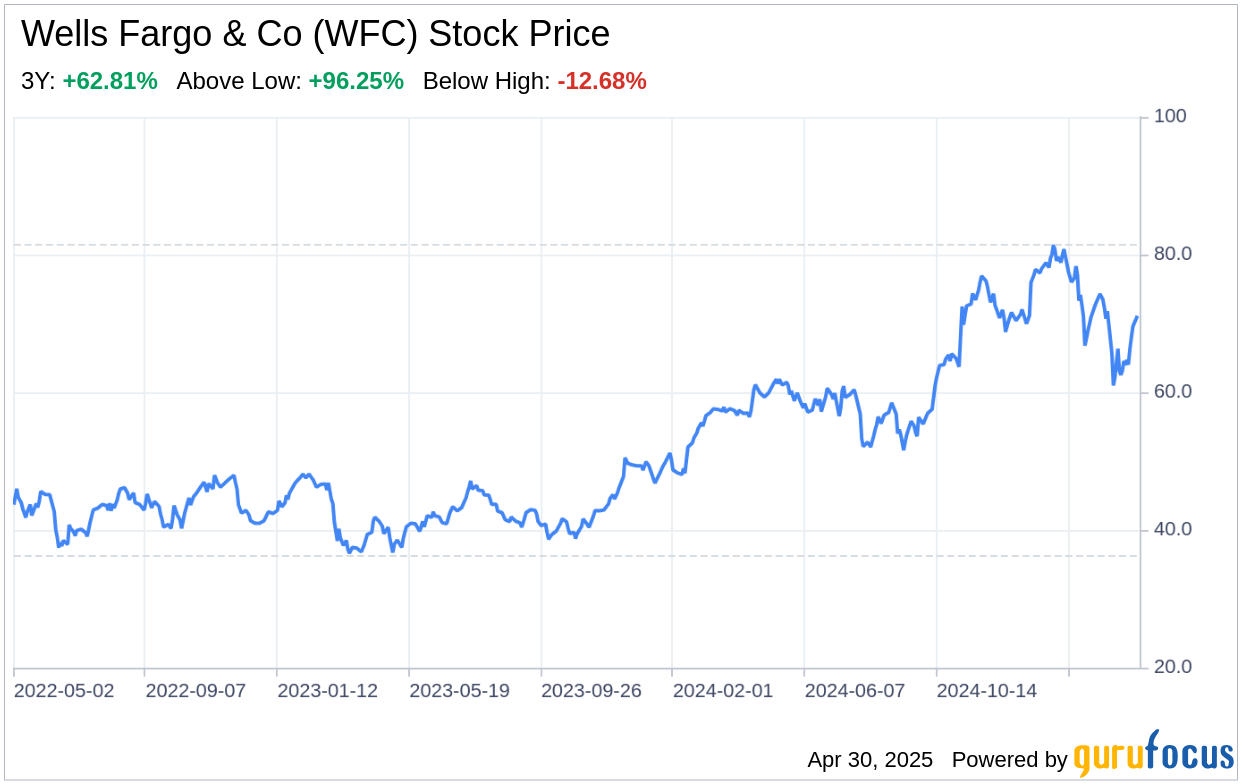Wells Fargo & Co (WFC, Financial), a titan in the US banking sector, filed its 10-Q report on April 29, 2025, offering a window into its financial health and strategic positioning. With approximately $1.9 trillion in assets, the company operates through four primary segments, focusing predominantly on the US market. Despite a 3% dip in total revenue, Wells Fargo demonstrated resilience with a 6% increase in net income, reaching $4.9 billion. This performance was underpinned by a decrease in noninterest expenses and a significant reduction in income tax expense. However, net interest income experienced a downturn, primarily due to lower interest rates and a decrease in loan balances. The company's strong capital and liquidity positions, with a CET1 ratio well above regulatory requirements, provide a stable foundation for navigating the competitive landscape.

Strengths
Robust Financial Performance: Wells Fargo & Co (WFC, Financial) has exhibited a solid financial performance, with a 6% increase in net income year-over-year, reaching $4.9 billion in the first quarter of 2025. This strength is further highlighted by a 7% rise in net income applicable to common stock, showcasing the company's ability to generate profits despite market challenges. The bank's earnings per common share also saw an increase from $1.21 to $1.41, indicating a robust return on equity for shareholders.
Capital and Liquidity Fortitude: The company's capital and liquidity positions are commendable. With a CET1 ratio of 11.09%, Wells Fargo comfortably exceeds the regulatory minimum, demonstrating a strong buffer against potential financial shocks. The total loss-absorbing capacity (TLAC) stands at 25.11%, surpassing the regulatory minimum of 21.50%. Additionally, the liquidity coverage ratio (LCR) of 125% is well above the 100% requirement, ensuring the bank's ability to meet short-term obligations.
Weaknesses
Revenue Decline: Despite a strong net income, Wells Fargo & Co (WFC, Financial) reported a 3% decrease in total revenue, primarily driven by a 6% reduction in net interest income. This decline reflects the challenges posed by the current interest rate environment and the competitive pressures in the banking industry. The decrease in loan balances, particularly in commercial real estate and residential mortgage portfolios, has contributed to this downward trend in revenue.
Operational and Legal Risks: Wells Fargo continues to grapple with operational and legal challenges, as evidenced by the various legal actions and proceedings outlined in the 10-Q filing. These issues not only pose financial risks but also affect the company's reputation and customer trust. The bank's operating losses, although decreased, still represent a significant expense that can impact overall profitability.
Opportunities
Strategic Acquisitions: The recent acquisition of the remaining interest in Wells Fargo Merchant Services indicates the company's strategic intent to expand its service offerings. This move is expected to increase noninterest income and provide new revenue streams, which can offset the decline in net interest income and contribute to long-term growth.
Technology and Digital Banking: Wells Fargo has the opportunity to invest further in technology and digital banking services to enhance customer experience and operational efficiency. With the increasing trend towards online and mobile banking, the company can leverage its strong capital base to innovate and capture a larger market share in the digital space.
Threats
Interest Rate Fluctuations: The bank's net interest income is sensitive to interest rate changes, as seen in the recent decline due to lower interest rates on floating rate assets. Continued volatility in interest rates poses a threat to Wells Fargo's revenue and profitability, necessitating effective interest rate risk management strategies.
Regulatory and Compliance Pressures: Wells Fargo operates in a highly regulated environment and is subject to numerous consent orders and regulatory actions. Compliance with these requirements demands significant resources and can restrict the company's operational flexibility. Any failure to adhere to regulatory standards can result in substantial penalties and further reputational damage.
In conclusion, Wells Fargo & Co (WFC, Financial) exhibits a strong financial foundation with a robust increase in net income and a solid capital and liquidity position. However, the company faces challenges in the form of revenue decline and ongoing operational and legal risks. Opportunities for growth lie in strategic acquisitions and the expansion of digital banking services, while threats from interest rate fluctuations and regulatory pressures loom. Wells Fargo's ability to navigate these dynamics will be critical in maintaining its competitive edge and ensuring long-term success.
This article, generated by GuruFocus, is designed to provide general insights and is not tailored financial advice. Our commentary is rooted in historical data and analyst projections, utilizing an impartial methodology, and is not intended to serve as specific investment guidance. It does not formulate a recommendation to purchase or divest any stock and does not consider individual investment objectives or financial circumstances. Our objective is to deliver long-term, fundamental data-driven analysis. Be aware that our analysis might not incorporate the most recent, price-sensitive company announcements or qualitative information. GuruFocus holds no position in the stocks mentioned herein.
